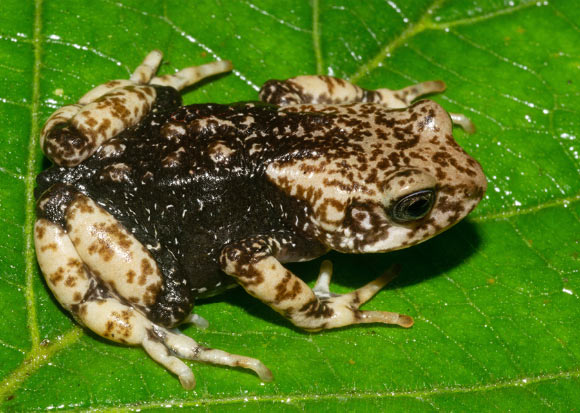A research team led by University of Copenhagen scientists has described three new species of the tree toad genus Nectophrynoides from Tanzania’s Eastern Arc Mountains.

Nectophrynoides luhomeroensis, adult in life. Image credit: Thrane et al., doi: 10.3897/vz.75.e167008.
The genus Nectophrynoides belongs to the family Bufonidae and, until now, consisted of 13 recognized species that are endemic to moist forests and grasslands in Tanzania.
Commonly called tree toads, members of Nectophrynoides exhibit viviparous reproduction, a trait that is extremely rare among frogs.
All species of Nectophrynoides are found in the Eastern Arc Mountains, except Nectophrynoides viviparus, which is also found in the adjacent Southern Highlands of Tanzania.
“The three new species of frogs belong to an unusual group of African toads in the genus Nectophrynoides,” said Dr. Christian Thrane from the University of Copenhagen and colleagues.
“Instead of laying eggs that hatch into tadpoles, the female tree toads carry their offspring inside their bodies and give birth to fully formed, tiny toads.”
“This makes them among the very few amphibians in the world capable of internal fertilization and true live birth.”
“It’s common knowledge that frogs grow from tadpoles — it’s one of the classic metamorphosis paradigms in biology,” said Dr. Mark D. Scherz from the Natural History Museum Denmark.
“But the nearly 8,000 frog species actually have a wide variety of reproductive modes, many of which don’t closely resemble that famous story.”
“Only a handful of frog species from South America and Southeast Asia have developed similar strategies making these toads a rare case in the animal kingdom.”
“Live-bearing is exceptionally rare among frogs and toads, practiced by less than 1% of frogs species, making these new species exceptionally interesting,” said Dr. H. Christoph Liedtke, a researcher at the Spanish National Research Council.
In the study, the authors for 257 specimens assigned to the Nectophrynoides viviparous complex.
Based on their results, they identified three new species: Nectophrynoides luhomeroensis, Nectophrynoides uhehe, and Nectophrynoides saliensis.
“The description of three new species brings the number of known viviparous anurans to 20 species worldwide, of which 16 species belong to the genus Nectophrynoides,” the researchers said.
“The distinctive reproduction and biology that these bufonids exhibit highlight the potential functional loss, if these species go extinct.”
“The risk of losing these species and their contribution to functional diversity in amphibians should be reasons to increase conservation efforts in order to protect them.”
“More surveys are needed to fully understand the behavior and ecology of these remarkable arboreal viviparous bufonids.”
The discovery is reported in a paper in the journal Vertebrate Zoology.
_____
C. Thrane et al. 2025. Museomics and integrative taxonomy reveal three new species of glandular viviparous tree toads (Nectophrynoides) in Tanzania’s Eastern Arc Mountains (Anura: Bufonidae). Vertebrate Zoology 75: 459-485; doi: 10.3897/vz.75.e167008







